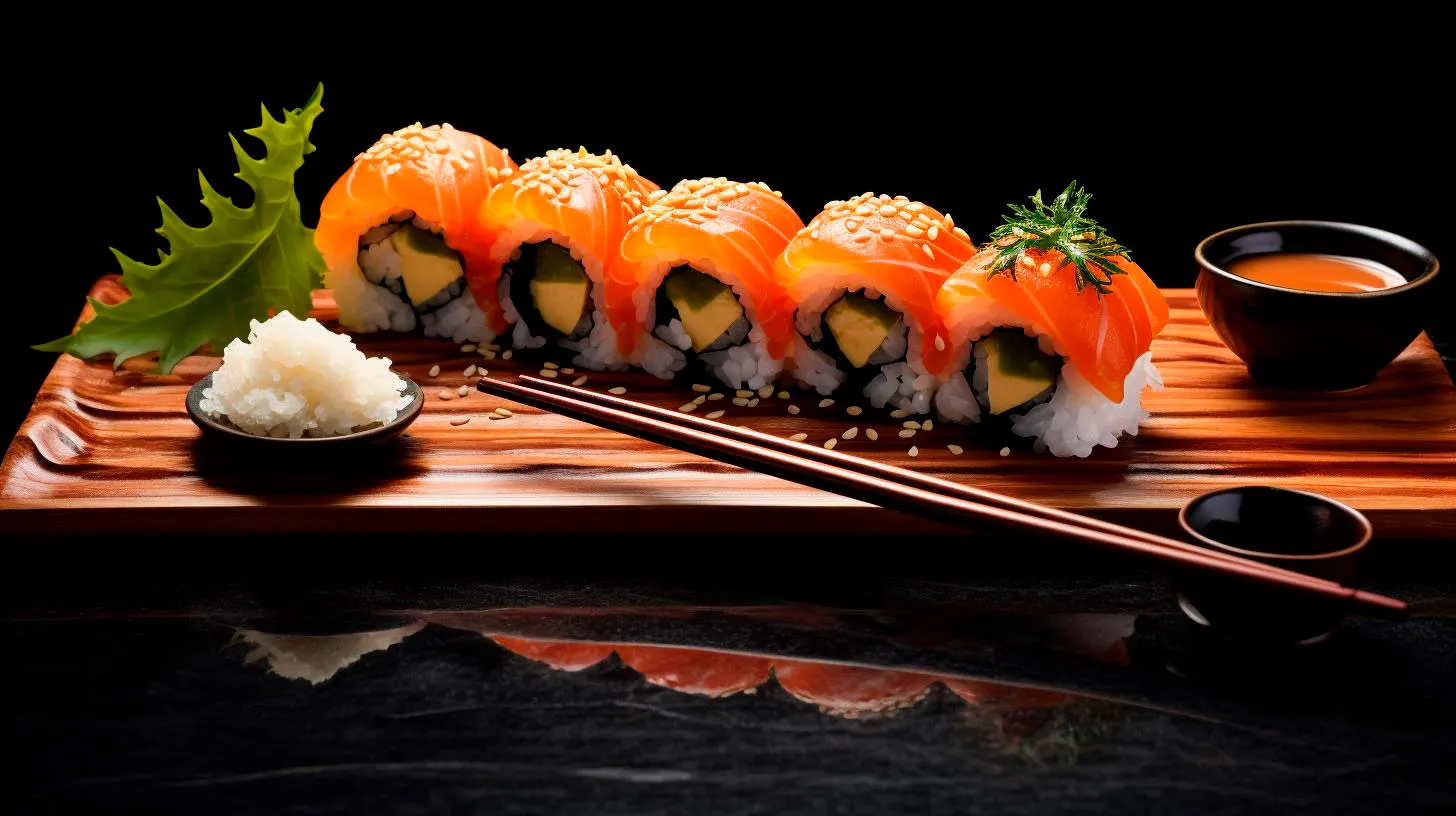Makizushi: Mastering the Art of Rolled Sushi
Whether you’re a sushi enthusiast or a beginner in Japanese cuisine, mastering Makizushi can elevate your sushi-making skills to a whole new level. In this article, we will explore the intricacies of Makizushi, highlighting its key features, advantages, and key takeaways.
The Basics of Makizushi
Before we dive into the details, let’s take a look at the basic components of Makizushi:
- Nori: The outer layer of the sushi roll is made of Nori, a thin sheet of seaweed. It adds a unique flavor and texture to the roll.
- Sushi Rice: Makizushi typically uses sushi rice, which is starchy, short-grain white rice seasoned with vinegar, sugar, and salt. The sticky texture of sushi rice helps hold the ingredients together.
- Fillings: Makizushi can be filled with a variety of ingredients, ranging from raw or cooked fish, vegetables, pickles, or even tofu. The options are endless, allowing for endless creativity.
Making Makizushi
Creating your own Makizushi at home may seem intimidating at first, but with practice and the right technique, you can become a Makizushi master. Here’s a step-by-step guide:
1. Prepare the Ingredients
Gather your preferred fillings, such as fresh fish, sliced vegetables, or cooked ingredients. Make sure they are sliced into thin strips for easy rolling and even distribution of flavors.
2. Roll the Makisu
A bamboo sushi mat called Makisu is used to roll the ingredients together. Place a sheet of Nori on the Makisu, shiny side down, and spread a thin layer of seasoned sushi rice over it, leaving a small border uncovered.
3. Add the Fillings
Arrange your chosen fillings in a line along the edge closest to you. Be mindful not to overstuff the roll, as it might become difficult to roll properly. Leave some space at the far edge to seal the roll later on.
4. Roll the Makizushi
Using the Makisu, start rolling the Nori tightly, applying gentle pressure to ensure a compact roll. Wet the uncovered border of Nori slightly to seal the roll completely.
5. Slice and Serve
With a sharp knife, slice the Makizushi into bite-sized pieces. Dip the knife in water or vinegar between each cut to prevent sticking. Arrange the sushi rolls on a plate and serve them alongside soy sauce, wasabi, and pickled ginger for a complete sushi experience.
Advantages of Makizushi
Makizushi offers several advantages that make it a popular choice among sushi lovers:
- Portability: The cylindrical shape of Makizushi makes it easy to grab and eat on the go, making it a popular choice for picnics or lunchboxes.
- Customization: Makizushi allows for endless customization, catering to individual preferences and dietary restrictions. Whether you’re a vegetarian or a seafood lover, there’s a Makizushi roll for everyone.
- Versatility: The wide range of fillings and flavors in Makizushi ensures that there is always something new to explore. From classic tuna rolls to innovative combinations, the versatility of Makizushi knows no bounds.
Key Takeaways
Becoming a Makizushi master requires practice and a touch of creativity. Here are some key takeaways to remember:
- Master the art of rolling sushi by practicing with a bamboo sushi mat.
- Experiment with different fillings and flavor combinations to create your personalized Makizushi rolls.
- Don’t be afraid to get creative with presentation – colorful ingredients and garnishes can elevate the visual appeal of your Makizushi.
- Enjoy your Makizushi with soy sauce, wasabi, and pickled ginger for a well-rounded sushi experience.
As you embark on your journey to become a Makizushi master, remember that practice makes perfect. Experiment with different ingredients, flavors, and rolling techniques to find your own signature Makizushi rolls. With time, patience, and a dash of creativity, you’ll be rolling out delicious Makizushi creations that will impress your family and friends.
Nigiri: Unveiling the Secrets of Hand-Pressed Sushi
Though simple in appearance, there is a lot more to nigiri than meets the eye. In this article, we will take a closer look at the art of hand-pressed sushi and discover the secrets that make nigiri a beloved culinary masterpiece.
The Origins of Nigiri Sushi
Nigiri sushi traces its roots back to the streets of Tokyo, Japan, during the early 19th century. It originated as a quick and convenient way for busy Tokyoites to grab a bite to eat on the go. Over time, nigiri evolved into an artful presentation of carefully selected ingredients, expertly crafted by sushi chefs who dedicated their lives to perfecting their skills.
The Anatomy of Nigiri Sushi
One of the defining characteristics of nigiri sushi is the combination of perfectly seasoned sushi rice and fresh fish or other toppings. The sushi rice is the foundation of every nigiri, made by combining short-grain rice with a mixture of rice vinegar, sugar, and salt. It is essential to achieve the right balance of flavors in the rice to complement the toppings.
The fish used in nigiri varies depending on availability and seasonality. Popular fish choices for nigiri include tuna, salmon, yellowtail, and shrimp. The fish must be of the highest quality, ensuring freshness and top-notch taste. Additionally, other toppings such as roe, egg, and even vegetables can be used to create unique flavor combinations.
The Secrets Behind Hand-Pressing Nigiri
Hand-pressing nigiri requires a delicate touch and thorough understanding of sushi craftsmanship. Here are some secrets sushi chefs employ to create the perfect piece of nigiri:
- Temperature control: Sushi rice should be slightly warm when crafting nigiri to enhance the taste and texture of the final product.
- Hand technique: Sushi chefs use their hands to gently mold the rice into a compact oval shape, ensuring it holds together without being too tightly packed.
- Balanced portioning: The amount of rice and fish must be carefully balanced, with neither overpowering the other. This delicate equilibrium is crucial for nigiri’s harmonious taste.
The Appreciation of Nigiri Sushi
A true sushi aficionado understands and appreciates the art of nigiri sushi. Here are some key takeaways to help you appreciate the intricate details behind nigiri:
- Freshness: Nigiri showcases the freshness of the fish, allowing you to experience its flavors and textures in their purest form.
- Simplicity: Nigiri’s simplicity allows you to savor the delicate balance of flavors between the rice and toppings.
- Visual presentation: Nigiri is often displayed beautifully, showcasing the skill and aesthetic sensibilities of the sushi chef.
The Growing Popularity of Nigiri
Nigiri sushi has gained immense popularity worldwide, becoming a staple in Japanese cuisine establishments around the globe. Its simplicity, freshness, and elegance have captivated sushi enthusiasts and food lovers alike. According to industry statistics:
- In 2019, the global sushi market was valued at approximately $14 billion.
- As per reports, the demand for nigiri sushi has been steadily increasing, with a growth rate of 3.8% between 2019 and 2024.
- Top sushi-consuming countries include the United States, Japan, and China.
These statistics demonstrate the rising popularity of not just sushi but also nigiri as a preferred choice among sushi lovers worldwide.
Final Thoughts
Nigiri sushi, with its simplicity and attention to detail, continues to mesmerize food enthusiasts with its delicate flavors and artful presentation. With the secrets behind hand-pressed nigiri now unveiled, you can appreciate the craftsmanship and skill that goes into creating this beloved Japanese culinary masterpiece. So next time you enjoy a plate of nigiri, savor each bite and embrace the secrets that make it truly special.
Temaki: Discovering the Joy of Hand-Rolled Sushi Cones
What is Temaki?
Temaki is a type of sushi that consists of a cone-shaped roll wrapped in a sheet of nori (seaweed). It’s made by combining fresh ingredients, including sushi rice, seafood, vegetables, and various sauces. What sets temaki apart from other sushi rolls is its shape – it resembles an ice cream cone, making it fun and interactive to eat.
When preparing temaki, the ingredients are placed in the center of the nori sheet, and then rolled tightly by hand. This allows for a customizable experience, as you can add your favorite ingredients and adjust the proportions to suit your taste. Once rolled, the temaki cone is typically enjoyed immediately to preserve its crunchy texture.
Advantages of Temaki:
- Customizable: Temaki provides endless possibilities for creative fillings, allowing you to tailor each cone to your personal preferences.
- Interactive: The unique cone shape of temaki makes it an interactive food experience, adding a touch of fun to your sushi meals.
- Freshness: Since temaki is rolled and enjoyed immediately, the ingredients retain their freshness, ensuring vibrant flavors in each bite.
- Portability: Temaki is easily portable, making it a great option for takeout, picnics, or sushi parties.
The Joy of Making Temaki
As a sushi enthusiast, you not only appreciate the taste of sushi but also enjoy the process of creating it. Making temaki at home can be a fun and rewarding experience. Here’s a simple step-by-step guide to get you started:
- Prepare your ingredients: Gather sushi rice, nori sheets, fresh seafood or vegetables, and any desired sauces or condiments.
- Wrap the sushi mat: Place a bamboo sushi mat on a clean surface and cover it with a sheet of plastic wrap to prevent sticking.
- Layout the nori sheet: Take a sheet of nori and place it shiny side-down on the sushi mat.
- Add the sushi rice: Wet your hands with water to prevent sticking, and evenly spread a layer of sushi rice over the nori sheet, leaving a small margin at the top.
- Customize your fillings: Add your chosen fillings – thinly sliced fish, avocado, cucumber, and sauce – along the rice layer.
- Roll it up: To shape the temaki cone, start rolling the sushi mat from the bottom corner, tucking in the fillings tightly. Continue rolling until the cone is formed.
- Enjoy your creation: Gently remove the temaki from the sushi mat, dip it in soy sauce, and take a satisfying bite of your homemade hand-rolled sushi cone.
Embrace your creativity and try out various ingredients and combinations to find your favorite flavor palette.
A Growing Trend
Temaki has gained popularity worldwide, and it’s no surprise why. This delightful sushi cone offers a range of flavors and textures, giving sushi lovers a unique dining experience. It is often featured in fusion sushi restaurants and has become a staple in sushi enthusiasts’ preferences.
Key Takeaways:
- Temaki is a hand-rolled sushi cone wrapped in a sheet of nori.
- It allows for customization and an interactive dining experience.
- Temaki is made by combining fresh ingredients, sushi rice, and various sauces.
- Making temaki at home can be a fun and rewarding activity.
- It has become a growing trend and a popular choice among sushi enthusiasts globally.
So, the next time you’re craving sushi, why not give temaki a try? With its customizable nature, interactive eating experience, and fresh flavors, temaki will surely add a new level of joy to your sushi adventures. Roll up your sleeves and embark on the journey of hand-rolled sushi – temaki.
Sashimi: Exploring the Delicate Balance of Raw Fish
The Cultural Significance of Sashimi
Sashimi has deep roots in Japanese culture and is considered an integral part of their culinary heritage. Dating back to the Muromachi period in the 14th century, sashimi was initially served as a simple side dish. Over time, it evolved into a gourmet delicacy, admired for its simplicity and elegance. Today, sashimi is commonly served as an appetizer or the centerpiece of an exquisite meal in Japanese restaurants worldwide.
Unveiling the Art of Sashimi
Sashimi is not just about raw fish; it involves a meticulous art form that highlights the natural flavors and textures of the fish. The fish is skillfully sliced into thin, bite-sized pieces, with utmost precision and attention to detail. The delicacy of sashimi lies in its visual appeal, as each slice is carefully arranged on a plate, accompanied by garnishes like daikon radish, shiso leaves, and soy sauce for dipping.
Key Takeaways:
- Sashimi is a traditional Japanese delicacy known for its meticulous presentation.
- The art of sashimi lies in the precise slicing and arrangement of the fish.
- Sashimi is often garnished with ingredients like daikon radish and shiso leaves.
The Variety of Fish
Sashimi showcases an extensive range of fish varieties, each offering a unique flavor profile and texture. While tuna and salmon are the most popular choices, other varieties such as yellowtail, mackerel, and snapper are equally delightful. It’s important to select fish that is as fresh as possible, as only then can the true flavors be enjoyed to the fullest extent.
Key Takeaways:
- Tuna and salmon are the most popular fish choices for sashimi.
- Other delicious options include yellowtail, mackerel, and snapper.
- Freshness is crucial to savoring the true flavors of sashimi.
The Health Benefits of Sashimi
In addition to its exquisite taste, sashimi offers several health benefits. As it is consumed raw, the fish retains more of its natural nutrients, including omega-3 fatty acids, which promote heart health and reduce inflammation. Sashimi is also low in calories and carbohydrates, making it an ideal choice for those following a healthy and balanced diet.
Key Takeaways:
- Sashimi is rich in omega-3 fatty acids, promoting heart health and reducing inflammation.
- It is a low-calorie and low-carbohydrate option, suitable for a balanced diet.
- Consuming sashimi allows you to enjoy the natural nutrients of the fish.
In Conclusion
Sashimi is not just a dish; it represents the harmony between humans and nature. With its elegant presentation, diverse fish options, and numerous health benefits, sashimi continues to captivate food enthusiasts worldwide. So, the next time you visit a Japanese restaurant or have the opportunity to try sashimi, savor each bite and appreciate the delicate balance of flavors that raw fish can offer.


